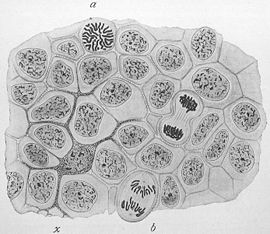
Edmund Beecher Wilson
Encyclopedia

United States
The United States of America is a federal constitutional republic comprising fifty states and a federal district...
zoologist and geneticist
Geneticist
A geneticist is a biologist who studies genetics, the science of genes, heredity, and variation of organisms. A geneticist can be employed as a researcher or lecturer. Some geneticists perform experiments and analyze data to interpret the inheritance of skills. A geneticist is also a Consultant or...
. He wrote one of the most famous textbooks in the history of modern biology, The Cell.
Career
Wilson was born in GenevaGeneva, Illinois
Geneva is the county seat of Kane County, Illinois. It is located on the western fringe of the Chicago suburbs. As of the 2010 census, the city had a total population of 26,652. Geneva is part of a tri-city area, along with St. Charles and Batavia...
, Illinois
Illinois
Illinois is the fifth-most populous state of the United States of America, and is often noted for being a microcosm of the entire country. With Chicago in the northeast, small industrial cities and great agricultural productivity in central and northern Illinois, and natural resources like coal,...
, and graduated from Yale
Yale University
Yale University is a private, Ivy League university located in New Haven, Connecticut, United States. Founded in 1701 in the Colony of Connecticut, the university is the third-oldest institution of higher education in the United States...
in 1878. He earned his doctorate
Doctorate
A doctorate is an academic degree or professional degree that in most countries refers to a class of degrees which qualify the holder to teach in a specific field, A doctorate is an academic degree or professional degree that in most countries refers to a class of degrees which qualify the holder...
at Johns Hopkins
Johns Hopkins University
The Johns Hopkins University, commonly referred to as Johns Hopkins, JHU, or simply Hopkins, is a private research university based in Baltimore, Maryland, United States...
in 1881.
He was a lecturer at Williams College
Williams College
Williams College is a private liberal arts college located in Williamstown, Massachusetts, United States. It was established in 1793 with funds from the estate of Ephraim Williams. Originally a men's college, Williams became co-educational in 1970. Fraternities were also phased out during this...
in 1883–84 and at the Massachusetts Institute of Technology
Massachusetts Institute of Technology
The Massachusetts Institute of Technology is a private research university located in Cambridge, Massachusetts. MIT has five schools and one college, containing a total of 32 academic departments, with a strong emphasis on scientific and technological education and research.Founded in 1861 in...
in 1884–85. He served as professor
Professor
A professor is a scholarly teacher; the precise meaning of the term varies by country. Literally, professor derives from Latin as a "person who professes" being usually an expert in arts or sciences; a teacher of high rank...
of biology
Biology
Biology is a natural science concerned with the study of life and living organisms, including their structure, function, growth, origin, evolution, distribution, and taxonomy. Biology is a vast subject containing many subdivisions, topics, and disciplines...
at Bryn Mawr College
Bryn Mawr College
Bryn Mawr College is a women's liberal arts college located in Bryn Mawr, a community in Lower Merion Township, Pennsylvania, ten miles west of Philadelphia. The name "Bryn Mawr" means "big hill" in Welsh....
from 1885 to 1891.
He spent the balance of his career at Columbia University
Columbia University
Columbia University in the City of New York is a private, Ivy League university in Manhattan, New York City. Columbia is the oldest institution of higher learning in the state of New York, the fifth oldest in the United States, and one of the country's nine Colonial Colleges founded before the...
where he was successively adjunct professor of biology (1891–94), professor of invertebrate
Invertebrate
An invertebrate is an animal without a backbone. The group includes 97% of all animal species – all animals except those in the chordate subphylum Vertebrata .Invertebrates form a paraphyletic group...
zoology (1894–1897), and professor of zoology (from 1897).
Wilson is credited as America's first cell biologist. In 1898 he used the similarity in embryo
Embryo
An embryo is a multicellular diploid eukaryote in its earliest stage of development, from the time of first cell division until birth, hatching, or germination...
s to describe phylogenetic relationships. By observing spiral cleavage in molluscs, flatworm
Flatworm
The flatworms, known in scientific literature as Platyhelminthes or Plathelminthes are a phylum of relatively simple bilaterian, unsegmented, soft-bodied invertebrate animals...
s and annelid
Annelid
The annelids , formally called Annelida , are a large phylum of segmented worms, with over 17,000 modern species including ragworms, earthworms and leeches...
s he concluded that the same organs came from the same group of cells and concluded that all these organisms must have a common ancestor
Common descent
In evolutionary biology, a group of organisms share common descent if they have a common ancestor. There is strong quantitative support for the theory that all living organisms on Earth are descended from a common ancestor....
. He was elected a Fellow of the American Academy of Arts and Sciences
American Academy of Arts and Sciences
The American Academy of Arts and Sciences is an independent policy research center that conducts multidisciplinary studies of complex and emerging problems. The Academy’s elected members are leaders in the academic disciplines, the arts, business, and public affairs.James Bowdoin, John Adams, and...
in 1902.
He also discovered the chromosomal
Chromosome
A chromosome is an organized structure of DNA and protein found in cells. It is a single piece of coiled DNA containing many genes, regulatory elements and other nucleotide sequences. Chromosomes also contain DNA-bound proteins, which serve to package the DNA and control its functions.Chromosomes...
XY sex-determination system
XY sex-determination system
The XY sex-determination system is the sex-determination system found in humans, most other mammals, some insects and some plants . In this system, females have two of the same kind of sex chromosome , and are called the homogametic sex. Males have two distinct sex chromosomes , and are called...
in 1905—that males have XY and females XX sex chromosomes. Nettie Stevens
Nettie Stevens
Nettie Maria Stevens was an early American geneticist. She and Edmund Beecher Wilson were the first researchers to describe the chromosomal basis of sex....
independently made the same discovery the same year.
In 1907, he described, for the first time, the additional or supernumerary chromosomes, now called B-chromosomes
B chromosome
In addition to the normal karyotype, wild populations of many animal, plant, and fungi species contain B chromosomes . By definition, these chromosomes are not essential for the life of a species, and are lacking in some of the individuals...
.
Professor Wilson published many papers on embryology, and served as president
President of the American Association for the Advancement of Science
The American Association for the Advancement of Science , founded in 1848, is the world's largest general scientific society. It serves 262 affiliated societies and academies of science and engineering, representing 10 million individuals worldwide...
of the American Association for the Advancement of Science
American Association for the Advancement of Science
The American Association for the Advancement of Science is an international non-profit organization with the stated goals of promoting cooperation among scientists, defending scientific freedom, encouraging scientific responsibility, and supporting scientific education and science outreach for the...
in 1913.
For his volume, The Cell in Development and Inheritance, Wilson was awarded the Daniel Giraud Elliot Medal
Daniel Giraud Elliot Medal
The Daniel Giraud Elliot Medal is awarded by the U.S. National Academy of Sciences "for meritorious work in zoology or paleontology published in a three- to five-year period." Named after Daniel Giraud Elliot, it was first awarded in 1917....
from the National Academy of Sciences
United States National Academy of Sciences
The National Academy of Sciences is a corporation in the United States whose members serve pro bono as "advisers to the nation on science, engineering, and medicine." As a national academy, new members of the organization are elected annually by current members, based on their distinguished and...
in 1925. The American Society for Cell Biology
The American Society for Cell Biology
American Society for Cell Biology is a learned society that was founded in 1960.Its mission statement states:- History :On 6 April 1959 the United States National Academy of Sciences passed a resolution for the establishment of a "national society of cell biology to act as a national...
annually awards the E. B. Wilson Medal
E. B. Wilson Medal
The American Society for Cell Biology's highest honor for science, the E.B. Wilson Medal is presented at the Annual Meeting of the Society for significant and far-reaching contributions to cell biology over the course of a career. It is named after Edmund Beecher Wilson.- Medalists :The following...
in his honor.
Sutton and Boveri
In 1902 and 1903 Walter SuttonWalter Sutton
Walter Stanborough Sutton was an American geneticist and physician whose most significant contribution to present-day biology was his theory that the Mendelian laws of inheritance could be applied to chromosomes at the cellular level of living organisms...
suggested that chromosomes, which segregate in a Mendelian fashion, are hereditary units: "I may finally call attention to the probability that the association of paternal and maternal chromosomes in pairs and their subsequent separation during the reducing division ... may constitute the physical basis of the Mendelian law of heredity". Wilson, who was Sutton's teacher and Boveri's friend, called this the "Sutton-Boveri Theory
Boveri-Sutton chromosome theory
The Boveri–Sutton chromosome theory is a fundamental unifying theory of genetics which identifies chromosomes as the carriers of genetic material...
".
1902–1904: Theodor Heinrich Boveri (1862–1915), a German biologist, made several important contributions to chromosome theory in a series of papers, finally stating in 1904 that he had seen the link between chromosomes and Mendel's results in 1902 (although this is not documented in his publications). He said that chromosomes were "independent entities which retain their independence even in the resting nucleua... What comes out of the nucleus is what goes into it".
Works
- An Introduction to General Biology (1887), with W. T. SedgwickWilliam Thompson SedgwickWilliam Thompson Sedgwick was a key figure in shaping public health in the United States.William T...
- The Embryology of the Earthworm (1889)
- AmphioxusLanceletThe lancelets , also known as amphioxus, are the modern representatives of the subphylum Cephalochordata, formerly thought to be the sister group of the craniates. They are usually found buried in sand in shallow parts of temperate or tropical seas. In Asia, they are harvested commercially as food...
, and the Mosaic TheoryMosaic (genetics)In genetic medicine, a mosaic or mosaicism denotes the presence of two populations of cells with different genotypes in one individual who has developed from a single fertilized egg...
of Development (1893) - Atlas of Fertilization and KaryokinesisMitosisMitosis is the process by which a eukaryotic cell separates the chromosomes in its cell nucleus into two identical sets, in two separate nuclei. It is generally followed immediately by cytokinesis, which divides the nuclei, cytoplasm, organelles and cell membrane into two cells containing roughly...
(1895) - The Cell in Development and Inheritance (1896; second edition, 1915; third edition, 1925)

